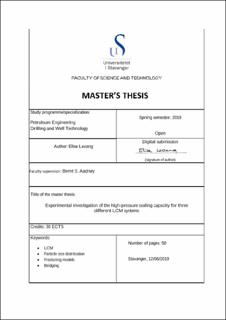| dc.description.abstract | As loss of circulation is still a major problem in the drilling industry, hundreds of lost circulation treatments are available on the market. The goal of this thesis is not to present a complete list of available products, but to give an overview of different treatments, investigating the level of effectiveness in different situations when exposed to high differential pressures.
The objective of this project was to investigate and compare the performance of three different commercial lost circulation materials; ONS-mixture, StopLoss and QuartzPack. All mixtures were tested in a simple water based mud system. The bridging and plugging capability was studied using a high pressure bridging apparatus, were the maximum applied pressure was 500 bar. To acquire a proper perception of each
separate LCM system, the experiment was conducted with slots of different geometry and width openings, allowing further investigation. Firstly, slots that simulate the fracture mouth with openings of 1, 2, 3 and 4 mm were analysed. Secondly, cone shaped slots that simulate a fracture that has a specif c length of 2.2 mm with openings of 3 - 1 mm, 3.5 - 1.5 mm and 4 - 2 mm. The intention for constructing the slots
was to examine the principle of the stress cage and fracture closure models.
The results of the experiment is presented by pressure plots and analysed in regards of maximum pressure, average pressure, total number of pressure peaks and average peak pressure. Furthermore, the measured data is applied to a simulated well to relate the laboratory data towards a field specific application. Finally, a discussion that involves a review of important factors that might have a large impact on the results, namely, the particle size distribution, hardness of the particles and the principle of
the fracturing models.
In this experiment, the key success factor for the various LCM mixtures were to hold the maximum pressure of 500 bar for an extended period. In other words, the performance accounted for can not include any pressure drops. The ONS-mixture was able to form an impermeable bridge for fracture opening widths of 1 and 2 mm, and the 3 - 1 mm and 3.5 - 1.5 mm. StopLoss could only create a solid bridge over the 1 mm opening fracture opening. Whereas for QuartzPack, a solid plug was formed in
the slots with openings of 3 - 1 mm and 3.5 - 1.5 mm. | en_US |

